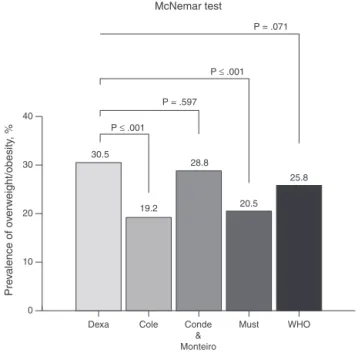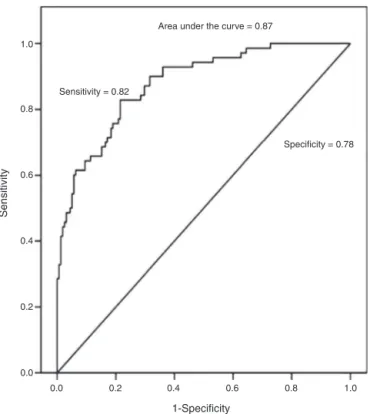www.jped.com.br
ORIGINAL
ARTICLE
Accuracy
of
different
cutoff
points
of
body
mass
index
to
identify
overweight
according
to
body
fat
values
estimated
by
DEXA
夽
Caroline
Cristina
Anzolin
a,
Diego
Augusto
Santos
Silva
b,
Edner
Fernando
Zanuto
a,
Suziane
Ungari
Cayres
c,
Jamile
Sanches
Codogno
a,
Paulo
Costa
Junior
a,
Dalmo
Roberto
Lopes
Machado
c,
Diego
Giulliano
Destro
Christofaro
a,∗aUniversidadeEstadualPaulista(UNESP),ProgramadePós-Graduac¸ãoemFisioterapia,PresidentePrudente,SP,Brazil bUniversidadeFederaldeSantaCatarina(UFSC),DepartamentodeEducac¸ãoFísica,Florianópolis,SC,Brazil
cUniversidadedeSãoPaulo(USP),EscoladeEducac¸ãoFísicaeEsporte,RibeirãoPreto,SP,Brazil
Received28August2015;accepted6April2016 Availableonline17August2016
KEYWORDS
Sensitivityand specificity; Adolescenthealth; Overweight; Obesity;
Bodycomposition
Abstract
Objective: Toevaluatethesensitivityandspecificityofdifferentcutoff pointsofbodymass
indexforpredictingoverweight/obesityaccordingtobodyfatvaluesestimatedbyDEXAamong
Brazilianadolescents.
Methods: Cross-sectionalstudyincluding229maleadolescentsaged10---15years,inwhichbody
adiposityandanthropometricmeasureswereassessed.NutritionalstatuswasclassifiedbyBMI
accordingtocutoffpointsdescribedinscientificliterature.
Results: ModerateagreementswereobservedbetweenbodyfatestimatedbyDEXAandcutoffs
proposedbyColeetal.(K=0.61),CondeandMonteiro(K=0.65),Mustetal.(K=0.61)andWHO
(K=0.63).TheBMIincontinuousformshowedgoodagreementwiththeDexa(ICC=0.72).The
highestsensitivitywasobservedforcutoffbyCondeandMonteiro(0.74[0.62,0.84])andthe
highestspecificitybyColeetal.(0.98[0.94,0.99]).FortheareasundertheROCcurveofcutoff
pointsanalyzed,significantdifferencecomparingthecutoffpointsby Coleetal.andConde
andMonteiro(0.0449[0.00294,0.0927])wasobserved.
Conclusions: The cutoff proposed by Conde andMonteiro was moresensitive inidentifying
overweightandobesitywhencomparedtothereferencemethod,andthecutoffproposedby
Coleetal.presentedthehighestspecificityforsuchoutcomes.
©2016SociedadeBrasileiradePediatria.PublishedbyElsevierEditoraLtda.Thisisanopen
accessarticleundertheCCBY-NC-NDlicense(http://creativecommons.org/licenses/by-nc-nd/
4.0/).
夽
Pleasecitethisarticleas:AnzolinCC,SilvaDA,ZanutoEF,CayresSU,CodognoJS,CostaJuniorP,etal.Accuracyofdifferentcutoff pointsofbodymassindextoidentifyoverweightaccordingtobodyfatvaluesestimatedbyDEXA.JPediatr(RioJ).2017;93:58---63.
∗Correspondingauthor.
E-mail:diegochristofaro@yahoo.com.br(D.G.Christofaro).
http://dx.doi.org/10.1016/j.jped.2016.04.010
PALAVRAS-CHAVE
Sensibilidadee especificidade; Saúdedo adolescente; Sobrepeso; Obesidade;
Composic¸ãocorporal
Precisãodediferentespontosdecortedoíndicedemassacorporalparaidentificar sobrepesodeacordocomvaloresdegorduracorporalestimadosporDEXA
Resumo
Objetivo: Avaliarasensibilidadeeaespecificidadedediferentespontosdecortedoíndicede
massacorporalparaoprognósticodesobrepeso/obesidadedeacordocomosvaloresdegordura
corporalestimadosporDEXAentreadolescentesbrasileiros.
Métodos: Estudotransversalqueinclui229adolescentesdosexomasculinocomidadeentre
10-15anos,noqualforamavaliadasaadiposidadecorporalemedidasantropométricas.Asituac¸ão
nutricionalfoiclassificadapeloIMCdeacordocomospontosdecortedescritosnaliteratura
científica.
Resultados: Foramobservadasconcordânciasmoderadasentreagorduracorporalestimadapor
DEXAeoscortespropostosporColeetal.[K=0,61],CondeeMonteiro[K=0,65],Mustetal.
[K=0,61]eaOMS[K=0,63].OIMCdeformacontínuamostrouumaboaconcordânciacoma
Dexa[CCI=0,72].Amaiorsensibilidadefoiobservadaem cortesporCondeeMonteiro[0,74
(0,62, 0,84)]e amaiorespecificidadepor Coleet al.[0,98 (0,94, 0,99)].Nasáreas abaixo
dacurvadeROCdepontosdecorteanalisados,foiobservadaumadiferenc¸asignificativaao
compararospontosdecortedeColeetal.eCondeeMonteiro[0,0449(0,00294,0,0927)].
Conclusões: O corte proposto por Conde e Monteiro foi mais sensível na identificac¸ão de
sobrepesoeobesidadeemcomparac¸ãoaométododereferência,eocortepropostoporCole
etal.apresentouamaiorespecificidadeparaessesresultados.
©2016SociedadeBrasileiradePediatria.PublicadoporElsevierEditoraLtda.Este ´eumartigo
OpenAccesssobumalicenc¸aCCBY-NC-ND(http://creativecommons.org/licenses/by-nc-nd/4.
0/).
Introduction
Obesityisamultifactorialdiseasewhoseincreasing preva-lence has been the focus of numerous investigations in both high-income1,2 andmiddle-incomecountries3 suchas Brazil.4 This fact isof increasing concerndue tothehigh incidenceofthisdiseaseinthepediatricpopulation.5
In this context, different strategies to prevent and fight childhood obesity have been outlined in order to assessnutritional status6,7frombody massscores. Various methods,suchasskinfoldthickness,waist-hipratio,waist circumference,andbodymassindex(BMI),canbeusedas nutritionalstatusindicators.8
Theseanthropometricindicatorshavelimitationsintheir measurements, but still show good predictive body fat values,8and findingsin literaturehave indicatedthat BMI is an appropriate tool for cardiometabolic risk screening in the pediatric population,9 although some differences
point to other assessment methods as better body fat
indicators.10 BMI has become a useful tool because it is consideredtobelowcostandeasy toapply,beingwidely used in epidemiological studies to diagnose excess body adiposity.11
There is no consensus in literature regarding the cut-offs to stratify BMI values into underweight, overweight, and obesity in the pediatric population; different cutoff pointshavebeendevelopedforthispurpose.12---15Thislack of consensus in cutoff points to classify the nutritional status of this population makes the comparison between studies conducted in different locations difficult, as with datafromasinglesample,differentoverweightandobesity
prevalence can be found, depending on the cutoff point used.16
Oneofthetechniquesthataremoreprecisethan anthro-pometricmeasurementstoestimatebodyfatandotherbody compositioncomponents is the dual energyX-ray absorp-tiometry (DEXA), which consists of ‘‘scanning’’ the body through X-rays that, after passing through the organism, aremeasured by an energy-discriminatingdetector. DEXA performstransverseanalysisofthebodyandisa noninva-sivetechniqueconsideredsafethatcanmeasurethreebody components:fatmass,freefatmass,andbonemass.17
This study aimed to analyze the sensitivity and
specificityofdifferentBMIcutoffpointsforpredicting over-weight/obesityaccordingtothebodyfatvaluesestimated byDEXAamongBrazilianmaleadolescents.
Methods
TotalbodyfatwasmeasuredbytheDEXAtechniqueusing aLunarDPX-MDdevice,byGeneralElectric(General Elec-tric Company, model LunarDPX-MD, USA), examining the entire body, with technique applied by a single trained evaluator. Initially, after testing the scanningquality, the volunteerswere positionedin supinepositionwithout the useofmetalobjectsandshoes,andduringthistest, they remainedstillfor aperiod ofapproximately15min. Total body fat wasexpressed in percentages values by the GE Medical Systems Lunar software (GE Healthcare Life Sci-ences,Lunar®,version4.7.,USA).Overweightandobesity classificationbybonedensitometryfollowedthe recommen-dationsofWilliamsetal.18(overweight/obesity≥25%body fat).
Body weight was measured using an electronic scale
Filizola® (modelo Filizola, Personal Line 200, Brazil) with
precisionof0.1kgandheightwasestimatedusingwooden stadiometerfixedtothewallmodelSanny(Sanny®,
Profis-sionalmodel,Brazil),withaccuracyof0.1cmandmaximum heightof 2m.These anthropometricvalues wereused to calculate BMIby body weightin kilograms dividedby the height,squared,inmeters.
Nutritionalstatuswasassessedby BMIaccording tothe followingcutoffs described inliterature: (i)Mustetal.,14 establishedfortheU.S.populationagedfrom6to74years; (ii)Conde andMonteiro,15 Brazilian classificationfor chil-dren and adolescentsaged 2---19 years;(iii) Cole etal.,12 a multicenter survey (Brazil, Great Britain, Hong Kong, Netherlands,Singapore,andtheUnitedStates),established for the population aged 0---25 years; (iv) and the World HealthOrganization(WHO)13forchildrenandadolescentes aged5---19years.
As the sample was composed of male adolescents
aged 10---15 years, the exact values of the
differ-ent cutoff points were: Must et al.14 (10 years=22.60; 11 years=23.73; 12 years=24.89; 13 years=25.93; 14 years=26.93; 15 years=27.76); Conde & Monteiro15 (10 years=13.09; 11 years=13.32; 12 years=13.63; 13 years=14.02; 14 years=14.49; 15 years=15.01); Cole etal.12 (10years=19.84;11years=20.55;12years=21.22; 13 years=21.91; 14 years=22.62; 15 years=23.29); and WHO13 (10years=18.60;11years=19.30;12years=20.10; 13years=20.09;14years=21.9;15years=22.80).
Sample characteristics were presented as mean and
standard deviation. Spearman correction (r) was applied to assess the relationship between percentage body fat estimatedby the referencemethodand theBMI, andthe agreementofthese valueswasverifiedbythe Kappatest forcategoricalvariablesandintra-classcoefficient correla-tion(ICC)forcontinuousvariables.Thecomparisonbetween the classification of overweight by DEXA and the cutoff points tested in the present study was performed using theMcNemartest.TheparametersoftheROCcurve (sen-sitivity, specificity, area under the curve [AUC], negative predictivevalue[NPV],andpositivepredictivevalue[PPV]) were used to verify the ability of cutoff points in pre-dictingoverweightandobesity.The statisticalsignificance adopted wasequal toor less than 5% andthe confidence intervalwas95%.Statistical analysis wasperformed using
the SPSS (SPSS Inc. Released 2007. SPSS for Windows,
version 15.0, USA) and MedCalc (MedCalc®, version 11.1,
Belgium).
0
Pre
va
lence of o
verweight/obesity
, %
Dexa Cole Conde
& Monteiro
Must WHO
McNemar test
P = .071
P = .597 P ≤ .001
P ≤ .001
10 20 30 40
30.5
19.2 28.8
20.5 25.8
Figure1 Comparisonbetween theoverweightclassification
by dual energy X-ray absorptiometry (DEXA) and body mass
index(BMI)cutoffpoints.
Results
The sampleconsistedof229maleadolescentsaged10---15 years.Themeancharacteristicsofthesamplewereas fol-lows:age,12.31(±1.78)years;weight,47.52(±13.77)kg; height,155.18(±13.41)cm;andBMI,19.41(±13.66)kg/m2. Seventyyoungsubjects(n=30.5%)wereclassifiedas hav-ingexcessbodyfatbyDEXA.Theprevalenceofoverweight whenanalyzingthevariouscutoffpointsusedinthisstudy wasshowninFig.1.Nosignificantdifferenceswereobserved betweentheoverweightclassificationbyDEXAcomparedto thecutoffpointsproposedbyCondeandMonteiro15 andby theWHO.13Significantdifferenceswereobservedusingthe cutoffpointsbyColeetal.12andbyMustetal.14
Whentherelationshipbetweenbodyfatvaluesidentified bythereferencemethodadoptedinthisstudyandBMI,good correlationwasobservedbetweenthesemethods(r=0.78). Theagreementofmeasurementsperformedbythedifferent cutoffpoints wasdetermined by theKappa test, and the following valueswereobserved: K=0.61 for Coleetal.12; K=0.65forCondeandMonteiro15;K=0.61forMustetal.14; and K=0.63 for WHO.13 When considering the agreement betweencontinuousvariables,fatpercentagebyDEXAand BMI,goodagreementwasobserved(ICC=0.72).
Table1showsinformationontheareaunderthecurve, sensitivity,specificity,PPV,andNPV.Thehighestsensitivity amongtheproposedcriteriawasverifiedforthecutoffof CondeandMonteiro15andthehighestspecificityforthe cut-offofColeetal.,12aswellasthehighestPPV.Thehighest NPVwasobservedforthecutoffofCondeandMonteiro.15
Table1 Diagnosticpropertiesofdifferentcutoffpointsofbodymassindextoidentifyoverweightaccordingtobodyfatvalues
estimatedbydualenergyX-rayabsorptiometry(DEXA).
AUC(95%CI) Sensitivity(95%CI) Specificity(95%CI) PPV(95%CI) NPV(95%CI)
Coleetal.12 0.78
(0.72;0.83)
0.58 (0.46;0.70)
0.98 (0.94;0.99)
0.93 (0.81;0.98)
0.84 (0.78;0.89)
CondeandMonteiro15 0.83
(0.77;0.87)
0.74 (0.62;0.84)
0.91 (0.85;0.95)
0.78 (0.67;0.87)
0.88 (0.83;0.93)
Mustetal.14 0.78
(0.73;0.84)
0.60 (0.48;0.72)
0.96 (0.92;0.99)
0.89 (0.76;0.96)
0.85 (0.78;0.89)
WHO13 0.81
(0.76;0.86)
0.70 (0.57;0.80)
0.93 (0.88;0.96)
0.83 (0.71;0.91)
0.87 (0.62;0.75)
AUC,areaunderthecurve;95%CI,95%confidenceinterval;PPV,positivepredictivevalue;NPV,negativepredictivevalue;WHO,World HealthOrganization.
Table2 ComparisonbetweenROCcurvesofdifferentcutoffpoints.
DifferencebetweenAUC(95%CI) p-Value
Coleetal.12versusCondeandMonteiro15 0.0449(0.00294;0.0927) 0.006* Coleetal.12versusMustetal.14 0.000917(0.0253;0.0271) 0.945 Coleetal.12versusWHO13 0.0358(0.00549;0.0771) 0.089
CondeandMonteiro15versusMustetal.14 0.0440(0.00161;0.0896) 0.059
CondeandMonteiro15versusWHO13 0.00908(0.0248;0.0430) 0.599
Mustetal.14versusWHO13 0.0349(0.00450;0.0743) 0.083
ROC,receiveroperatingcharacteristic,AUC,areaunderthecurve;WHO,WorldHealthOrganization.
* p≤0.05.
Table2showsthecomparisonsbetweendifferentareas
under the ROC curves and their respective confidence
intervals of differentcutoffpoints analyzed inthis study. Statisticallysignificantdifferenceswereobservedwhenthe
Area under the curve = 0.87
Sensitivity
1-Specificity
Sensitivity = 0.82 1.0
0.8
0.6
0.4
0.2
0.0
0.0 0.2 0.4 0.6 0.8 1.0
Specificity = 0.78
Figure2 Receiveroperating characteristic (ROC)curve for
bodymassindex(BMI)abilitytopredictoverweightestimated
bydualenergyX-rayabsorptiometry(DEXA).
cutoffpointsofColeetal.12andCondeandMonteiro15were compared.
Discussion
The present findings indicate that the cutoff established byConde andMonteiro15 showed higherAUCand sensitiv-ity, which helpsidentifying more efficiently the presence ofoverweightandobesityamongchildrenandadolescents. Conversely, Cole et al.12 showed higher specificity when comparedtotheotheroutcomes.
overweight/obesityishigh,23 whichmayexplainthelower sensitivitylevelsandthetendencyofsuchindexesto under-estimateoverweightandobesityintheBrazilianpopulation. The cutoff point proposed by the WHO13 shows large amplitudewhencomparedwiththeotherreferences,which mayhaveprovidedlowersensitivitytotheprognosisof over-weightandobesity.SimilarfindingswerereportedbyVeiga et al.24 However, when the ROC curves of cutoff points wereobserved, it was observed that thoseby Conde and Monteiro15showedmoresensitivecriticalvaluesinthe iden-tification of excess body fat compared to those by Cole etal.12Thisoccurredbecausethemodelwasbuiltbasedon dataobtainedfromyoungBraziliansafewyearsago,when obesity rates were not similar to the worrisome current reality.25Anotherfactoristhatthevaluesrecommendedfor eachagegroupbyCondeandMonteiro15werelowerthanthe othercutoffpointsanalyzedinthisstudy.
Althoughthesensitivityandspecificityresultswere sig-nificant, when analyzing the misclassification of cutoff pointscomparedwithDEXA,statisticallysignificant differ-enceswere observed in thecutoffpoints by Coleetal.12 and by Must et al.,14 may note that there may be erro-neousratingsonthebodyfatindexincertainpopulations,so thecutoffpointsestablishedbyConde andMonteiro15 and WHO,13 are lesslikelytobody fatmisclassification. More-overNeoviusetal.26examinedthemisclassificationofsome cutoffsin Swedishadolescentsand found abetter system ofexcessfatclassificationthroughthecutoffpointsofCole etal.12andWHO.13Thedifferencebetweenthefindingsmay berelatedthecharacteristicsanalyzedpopulation.
To use the differenttypes of cutoffpoints, healthcare professionals should be aware of the strengths and limi-tations of each cutoff point. For example, among those analyzedinthepresentstudy,thatbyCondeandMonteiro15 was more sensitive, but also has the greatest chance of detectingfalsepositives,i.e.,toclassifyasoverweight indi-viduals who are not. Unlike more specific cutoff points, thosebyColeetal.,12 byMustetal.,14 andbytheWHO13 mayclassifysomeadolescentswhoareoverweightasnormal weight.
Furthermore,alimitationtobeconsideredisthatthese differentcutoffpointsshouldbetestedagainstanumberof cardiovascularriskfactorsinadolescentssuchas hyperten-sion,diabetes,cholesterol,andtriglyceridestoassesstheir efficiencyindetectingcardiovascularrisks.
As Neouvis et al.,26 the present study also tested the accuracy,sensitivityandspecificityofBMIonacontinuous basisinpredictingoverweightobservablegoodAUC(Fig.2). TheseresultsshowthatthehighertheBMI,thegreaterare thechancesof the subjectpresentinga high fat percent-agebasedonBMIanalysisversusbodyfatobtainedbyDEXA. Thus,theuseofBMIbyhealthcareprofessionalsshouldbe encouraged,asitcorrelateswellwithbodyfat. Moreover, BMIisasimpleandinexpensivetechnique.
The following limitations of this study should be high-lighted:(i)thecross-sectionaldesign,whichdidnotallow fortheestablishmentofacausalrelationshipbetween out-comes;(ii)thesample,whichconsistedofmalevolunteers only;(iii)theuseofDEXAasreferencemethod,asprevious results have shown that this technique tends to overesti-mate the percentageof body fat in individuals with high bodyfat levelsandtounderestimateit in thosewithlow
fatlevels27;thus,foradolescentswithextremeBMIvalues, DEXAresultsmaynotbeasaccurate.Nonetheless,this tech-niqueismoreaccuratethananthropometricmeasurements toestimatebodyfat.Furtherstudiesshouldbecarriedout usingmoreaccuratemethods toestimate bodyfatandto verifythepossiblerelationshipbetweencutoffpoints.
Apracticalapplicationforobesityscreeningintheyoung populationcouldbetheuseofdifferentcutoffpoints simul-taneously;forexample,inthecase ofthisstudy,themost sensitive and specific, because if an adolescent is classi-fiedasoverweightbytwocutoffpoints,he/sheshouldbe closelymonitored.Fromtheseassessments,health promo-tioncould bebetter preparedin theschool environment. Referralofyoungoverweightsubjectsassessedatdifferent cutoff points to a Basic Healthcare Unit could be car-ried out withthe purpose of performing routine tests to prevent cardiovascularproblems typically associatedwith overweight.
Thus,itcanbeconcludedthatthecutoffpointsproposed byConde andMonteiro15 wasmoresensitive inidentifying overweight and obesity when compared to the reference method,andthecutoffpointsbyColeetal.12showedhigher specificityforsuchoutcomes.
Conflicts
of
interest
Theauthorsdeclarenoconflictsofinterest.
References
1.KoebnickC,SmithN,HuangK,MartinezMP,ClancyHA,KushiLH. Theprevalenceofobesityandobesity-relatedhealthconditions inalarge,multiethniccohortofyoungadultsinCalifornia.Ann Epidemiol.2012;22:609---16.
2.KwonY,OhS,ParkS,ParkY.Associationbetweenhousehold incomeandoverweightofKoreanandAmericanchildren:trends anddifferences.NutrRes.2010;30:470---6.
3.NtandouG,DelisleH,AguehV,Fayomi B.Abdominalobesity explainsthepositive rural---urban gradientin theprevalence ofthe metabolic syndrome in Benin, WestAfrica. Nutr Res. 2009;29:180---9.
4.Silveira JA, Colugnati FA, Cocetti M, Taddei JA. Secular trendsand factorsassociated withoverweightamong Brazil-ianpreschoolchildren:PNSN-1989,PNDS-1996,and2006/07.J Pediatr(RioJ).2014;90:258---66.
5.SardinhaLB,SantosR,ValeS,SilvaAM,FerreiraJP,Raimundo AM, et al. Prevalence of overweight and obesity among Portuguese youth: a study in a representative sample of 10---18-year-oldchildrenand adolescents.IntJPediatrObes. 2011;6:e124---8.
6.LindsayRS,Hanson RL, RoumainJ,Ravussin E,KnowlerWC, TataranniPA.Bodymassindexasameasureofadiposityin chil-drenandadolescents:relationshiptoadipositybydualenergy X-rayabsorptiometryandtocardiovascularriskfactors.JClin EndocrinolMetab.2001;86:4061---7.
7.NeoviusM,Linne Y,Rossner S.BMI,waist-circumferenceand waist-hip-ratioasdiagnostic testsfor fatnessin adolescents. IntJObes(Lond).2005;29:163---9.
9.Weber DR, Leonard MB, Shults J, Zemel BS. A comparison of fat and lean body mass index to BMI for the identifica-tionofmetabolicsyndromeinchildrenandadolescents.JClin EndocrinolMetab.2014;99:3208---16.
10.Welborn TA, Dhaliwal SS. Preferred clinical measures of central obesity for predicting mortality. Eur J Clin Nutr. 2007;61:1373---9.
11.RezendeFA, RosadoLE,Franceschinni SC,RosadoGP,Ribeiro RC.Aplicabilidadedoíndicedemassacorporalnaavaliac¸ãoda gorduracorporal.RevBrasMedEsporte.2010;16:90---4. 12.Cole TJ, Bellizzi MC, Flegal KM, Dietz WH. Establishing a
standarddefinitionforchildoverweightandobesityworldwide: internationalsurvey.BMJ.2000;320:1240---3.
13.deOnisM,OnyangoAW,BorghiE,SiyamA,NishidaC,Siekmann J.Developmentof a WHOgrowth reference for school-aged childrenand adolescents.Bull WorldHealth Organ.2007;85: 660---7.
14.MustA,DallalGE,DietzWH.Referencedataforobesity:85th and95thpercentilesofbodymassindex(wt/ht2)andtriceps skinfoldthickness.AmJClinNutr.1991;53:839---46.
15.CondeWL,MonteiroCA.Bodymassindexcutoffpointsfor evalu-ationofnutritionalstatusinBrazilianchildrenandadolescents. JPediatr(RioJ).2006;82:266---72.
16.PelegriniA,SilvaDA,GayaAC,PetroskiEL.Comparisonofthree criteriafor overweightand obesity classification inBrazilian adolescents.NutrJ.2013;12:5.
17.Sant’Anna MS, Priore SE, Franceschini SC. Methods of body composition evaluation in children. Rev Paul Pediatr. 2009;27:315---21.
18.WilliamsDP,GoingSB,LohmanTG,HarshaDW,SrinivasanSR, WebberLS,etal.Bodyfatnessandriskforelevatedblood pres-sure,totalcholesterol,andserumlipoproteinratiosinchildren andadolescents.AmJPublicHealth.1992;82:358---63.
19.SilvaHG,ChiaraVL,BarrosME,RegoAL,FerreiraA,PitasiBA, etal.Diagnosingthenutritionalstatusofschoolchildren:a com-parisonbetweenBrazilianandinternationalcriteria.JPediatr (RioJ).2008;84:550---5.
20.LinWY,LeeLT,ChenCY,LoH,HsiaHH,LiuIL,etal.Optimal cut-offvaluesforobesity:usingsimpleanthropometricindices topredictcardiovascularriskfactorsinTaiwan.IntJObesRelat MetabDisord.2002;26:1232---8.
21.Vieira AC, Alvarez MM, de Marins VM, Sichieri R, da Veiga GV. Accuracy of different body mass index reference val-ues to predictbody fat in adolescents. Cad Saude Publica. 2006;22:1681---90.
22.VitoloMR,CampagnoloPD,BarrosME,GamaCM,AnconaLopez F.Evaluationoftwoclassificationsforoverweightamong Brazil-ianadolescents.RevSaudePublica.2007;41:653---6.
23.FalknerB,CossrowND.Prevalenceofmetabolicsyndromeand obesity-associatedhypertensionintheracialethnicminorities oftheUnitedStates.CurrHypertensRep.2014;16:449. 24.VeigaGV,DiasPC,dosAnjosLA.Acomparisonofdistribution
curvesofbodymassindexfromBrazilandtheUnitedStatesfor assessingoverweightandobesityinBrazilianadolescents.Rev PanamSaludPublica.2001;10:79---85.
25.WangY,MonteiroC,PopkinBM.Trendsofobesityand under-weightinolderchildrenandadolescentsintheUnitedStates, Brazil,China,andRussia.AmJClinNutr.2002;75:971---7. 26.NeoviusMG,LinneYM,BarkelingBS,RossnerSO.Sensitivityand
specificityofclassificationsystemsforfatnessinadolescents. AmJClinNutr.2004;80:597---603.

